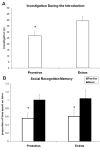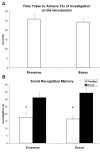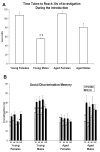Social recognition memory: influence of age, sex, and ovarian hormonal status
- PMID: 17673265
- PMCID: PMC2151760
- DOI: 10.1016/j.physbeh.2007.06.020
Social recognition memory: influence of age, sex, and ovarian hormonal status
Abstract
Social recognition memory underlies many forms of rodent interaction and can be easily tested in the laboratory. Sex differences in aspects of this memory have been reported among young adults, and some studies indicate an age-related decline among male rats. In contrast, neither the impact of natural fluctuations in ovarian hormones nor the performance of aged female rats on social recognition memory has been previously evaluated. In experiments 1 and 2, the social recognition memory of young adult female Long-Evans rats (age 3-5 months) was compared during proestrus and estrus, and performance was found to be stable across estrous cycle phases. In experiment 3, the social recognition memory of young adults as compared to aged (16.5-19.5 months) rats was tested using the social discrimination procedure, following delays of 15, 45, 90 or 120 min. The estropausal status of aged female rats was tracked during the experiment but was not found to influence memory ability. Males of both ages investigated juveniles (both novel and familiar) more than did females, although despite this difference, both sexes demonstrated robust memory. Interestingly, only young adult females were capable of demonstrating memory following the longest delay. Collectively, our findings indicate that the pattern of age-related changes in social recognition memory is subtle and that aging does not greatly alter the behavioral sex differences observed among young adults.
Figures



Similar articles
-
Sex differences and estropausal phase effects on water maze performance in aged rats.Neurobiol Learn Mem. 2000 Nov;74(3):229-40. doi: 10.1006/nlme.1999.3948. Neurobiol Learn Mem. 2000. PMID: 11031129
-
Sexually dimorphic aging of dendritic morphology in CA1 of hippocampus.Hippocampus. 2005;15(1):97-103. doi: 10.1002/hipo.20034. Hippocampus. 2005. PMID: 15390161
-
Aged rats: sex differences and responses to chronic stress.Brain Res. 2006 Dec 18;1126(1):156-66. doi: 10.1016/j.brainres.2006.07.047. Epub 2006 Aug 17. Brain Res. 2006. PMID: 16919611
-
Regulation of object recognition and object placement by ovarian sex steroid hormones.Behav Brain Res. 2015 May 15;285:140-57. doi: 10.1016/j.bbr.2014.08.001. Epub 2014 Aug 15. Behav Brain Res. 2015. PMID: 25131507 Free PMC article. Review.
-
Gonadal hormones provide the biological basis for sex differences in behavioral responses to cocaine.Horm Behav. 2004 Dec;46(5):509-19. doi: 10.1016/j.yhbeh.2004.04.009. Horm Behav. 2004. PMID: 15555492 Review.
Cited by
-
Aged neuronal nitric oxide knockout mice show preserved olfactory learning in both social recognition and odor-conditioning tasks.Front Cell Neurosci. 2015 Mar 27;9:105. doi: 10.3389/fncel.2015.00105. eCollection 2015. Front Cell Neurosci. 2015. PMID: 25870540 Free PMC article.
-
Social Memory and the Role of the Hippocampal CA2 Region.Front Behav Neurosci. 2019 Oct 1;13:233. doi: 10.3389/fnbeh.2019.00233. eCollection 2019. Front Behav Neurosci. 2019. PMID: 31632251 Free PMC article. Review.
-
Adolescent social isolation changes social recognition in adult mice.Behav Brain Res. 2011 Jan 20;216(2):647-51. doi: 10.1016/j.bbr.2010.09.007. Epub 2010 Sep 16. Behav Brain Res. 2011. PMID: 20849881 Free PMC article.
-
Sex differences in social investigation: effects of androgen receptors, hormones and test partner.J Neuroendocrinol. 2012 Aug;24(8):1144-53. doi: 10.1111/j.1365-2826.2012.02322.x. J Neuroendocrinol. 2012. PMID: 22487205 Free PMC article.
-
A dorsal CA2 to ventral CA1 circuit contributes to oxytocinergic modulation of long-term social recognition memory.J Biomed Sci. 2022 Jul 10;29(1):50. doi: 10.1186/s12929-022-00834-x. J Biomed Sci. 2022. PMID: 35811321 Free PMC article.
References
-
- Popik P, van Ree JM. Neurohypophyseal peptides and social recognition in rats. Prog Brain Res. 1998;119:415–36. - PubMed
-
- Bluthe RM, Dantzer R. Social recognition does not involve vasopressinergic neurotransmission in female rats. Brain Res. 1990;535(2):301–4. - PubMed
-
- Thor DH. Testosterone and persistance of social investigation in laboratory rats. J Comp Physiol Psychol. 1980;94(5):970–6. - PubMed
-
- de Vries GJ, Miller MA. Anatomy and function of extrahypothalamic vasopressin systems in the brain. Prog Brain Res. 1998;119:3–20. - PubMed
-
- Ferguson JN, Young LJ, Insel TR. The neuroendocrine basis of social recognition. Front Neuroendocrinol. 2002;23(2):200–24. - PubMed
Publication types
MeSH terms
Substances
Grants and funding
LinkOut - more resources
Full Text Sources
Medical

